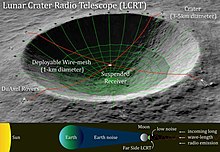Lunar Crater Radio Telescope
 | |
| Alternative names | LCRT |
|---|---|
| Location(s) | far side of the Moon |
| Telescope style | radio telescope |
| Diameter | 1 km (3,280 ft 10 in) |
The Lunar Crater Radio Telescope (LCRT) is a proposal by the NASA Institute for Advanced Concepts to create an ultra-long-wavelength (hereby wavelengths greater than 10 m – i.e., frequencies below 30 MHz) radio telescope inside a lunar crater on the far side of the Moon.[a] If completed, the telescope would be the largest filled-aperture radio telescope in the Solar System at 1 km in diameter.[1][2]

Concept of operations for building LCRT.
Notes[]
- ^ Radio telescopes on Earth can't probe the long-wavelength radio waves from the universe's Dark Ages, as the ionosphere reflect them through its layer of ions and electrons.[1]
References[]
- ^ a b O'Neill, Ian J.; Skelly, Clare (5 May 2021). "Lunar Crater Radio Telescope: Illuminating the Cosmic Dark Ages". NASA. Retrieved 6 May 2021.
- ^ "Lunar Crater Radio Telescope (LCRT) on the Far-Side of the Moon". NASA. 7 April 2020. Retrieved 9 April 2020.
External links[]
Categories:
- Radio telescopes
- Space telescopes
- Proposed NASA space probes
- Missions to the Moon
- Astronomy stubs